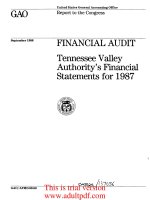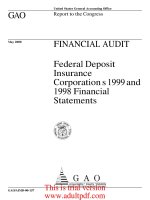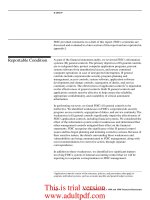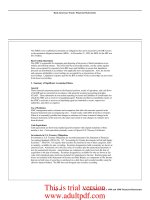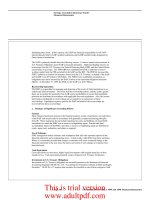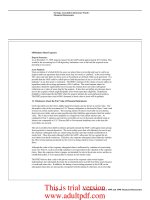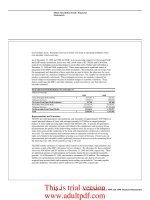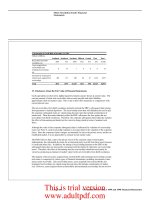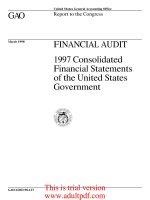United States Report to the Congress FINANCIAL AUDIT Examination of Customs’Fiscal Year _part3 docx
Bạn đang xem bản rút gọn của tài liệu. Xem và tải ngay bản đầy đủ của tài liệu tại đây (637.02 KB, 10 trang )
B-262376
Except for the limitations on the scope of our work described above, our
work was done in accordance with generally accepted government
auditing standards and
OMB
Bulletin 93-06, “Audit Requirements for
Federal Financial Statements.”
Charles A. Bowsher
Comptroller General
of the United States
May 28,1993
Pa6e 20
GAOAIMD-93-3 Cudoms’ 1992 Financial Statements
This is trial version
www.adultpdf.com
Page 21
GAOAIMD-93-3 Customs’ 1992 Financial Statements
This is trial version
www.adultpdf.com
Financial Statements
verview of Financial Entity
LETTER FROM THE COMMISSIONER
In the last 200 years, the mission of the U.S.
Customs Service has expanded from a focus on collection
of revenue to today's role as the Nation's primary border
enforcement agency responsible for enforcing laws and
regulations governing international traffic and trade.
Customs provides a broad spectrum of commercial,
enforcement,
and inspection services to the American
public. Every year, Customs processes hundreds of
millions of passengers,
millions of shipments of
merchandise (valued at over $500 billion), carriers, and
vehicles, in a swift,
efficient manner,
while at the same
time inhibiting the influx of contraband materials,
pirated copies of protected merchandise, and articles :
dangerous to the general public. In addition, Customs
acts to prevent the shipping abroad of dangerous and
hazardous materials, weapons, and high technology where
prohibited by law.
The enforcement role of Customs in
the economy and in the areas of national health and
welfare has continued to grow.
The challenges we face in the near future are
great. In the last decade,
world economic growth and the
increased interdependence of the global economy have
accelerated trade and rapidly increased our workloads.
The risks of prohibited goods entering our shores
undetected are growing,
while trafficking in illicit
narcotics and associated money laundering activities
continue as a major concern. In addition to these
mission challenges, however, another major concern is the
integrity and accuracy of the financial systems involved
in administering our programs and the adequacy of the
procedures in place to prevent fraud, waste, or
mismanagement of public funds.
The Chief Financial
Officer's
(CFO)
Act of 1990 places new emphasis on
government-wide efforts to promote better financial
management and maximize the effective use of limited
resources. Our actions to implement CFO requirements
have added impetus to the far-ranging financial
management improvements begun at Customs in the last
several years.
I have instituted an integrated planning
process at the Customs Service to measure our successes
and chart our future. The preparation of the current
Page 22
GAOAIMD-93-3 Customd 1992 Fiicial
Statementa
This is trial version
www.adultpdf.com
Financial Statement8
year CFO Report has presented an opportunity to take
stock of how well we are safeguarding and accounting for
the resources provided to implement our programs.
The
report provides an overview of our goals and functions as
well as a clear statement of how we are using program
resources.
As required by the
CFO
reporting process,
special emphasis has been placed on presentation of
performance indicators which relate our achievements to
the resources expended.
The report also points to significant
improvement in our cash management and funds control
processes,
in our accounting and reporting of revenues,
and in the reconciliation of Customs collections and
deposits.
Improved cost information has become available
through a new payroll system. This information will be
enhanced through implementation of a cost accounting
system being developed in FY 1993.
This year, Customs
implemented a new core financial system and will be
integrating ancillary systems with it as part of the
ongoing development of Customs Asset Information
Management System. Customs is also beginning the
redesign and enhancement of the financial aspects of its
commercial and revenue systems (the Automated Commercial
System). We have greatly expanded the scope and
intensity of efforts to improve management and internal
controls within the agency. Taken together, these
initiatives are resulting in coherent, comprehensive, and
effective procedures to fully utilize and account for
Customs resources. All of these efforts are in keeping
with what I perceive to be the ultimate goal of the CFO
Act.
I am proud of Customs accomplishments in
carrying out its mission of trade enforcement, trade
administration, and narcotics enforcement.
I am also
proud of our efforts to create an atmosphere of improved
financial management and I believe our Annual CFO Report
is an excellent vehicle to communicate our continued
progress in both areas.
Michael H. Lane
Acting Commissioner
U.S. Customs Service
Page 23
GAOAIMD-93-3 Customs’ 1992 Financial Statement8
II
! .’
This is trial version
www.adultpdf.com
Finaucial Statements
INTRODUCTION
IMPLEMENTING THE CFO ACT OF 1990
The Chief Financial Officers (CFO) Act of 1990 represents the most far-reaching financial
legislation in nearly 40 years. Customs is one of the pilot agencies for financial statement
preparation and audit by the U.S. General Accounting Office (GAO). Customs has fully realized
the need for greater management attention to financial management and recognized current
problems, which we have begun to address. The financial statements are intended to be of value
to users in making economic, social, and political decisions and in assessing our accountability.
In recognition of the need to be held accountable to our customers and stakeholders and the
requirements of the CFO Act of 1990, we have prepared comprehensive financial statements with
footnotes for FY 1992. The statements have
then
been audited by GAO. In preparing the
formats and footnote content of the financial statements, professional guidance was obtained from
a variety of sources. Further clarification on financial
statement
presentation is expected as the
Federal Accounting Standards Advisory Board (FASAB) addresses issues unique to the Federal
Government.
The Government Accounting Standards Board, Concepts Statement Number 1, states that
“Governmental accountability is based on the belief that the taxpayer has a right to know, a right
to receive openly declared facts that may lead to public debate by taxpayers and their elected
representatives” (paragraph 56). Accountability includes a requirement to render an account or
explain ones actions to someone else who has the authority to assess performance and to make
judgement and take action.
The impact of the CFO review and financial statement preparation process on Customs goes
beyond the finance function. Customs has begun to look carefully at the underlying financial
support structure throughout its organization. Using CFO audit findings to compliment already
existing cost-benefit analyses, Customs is now beginning to integrate its financial management
decisions with decisions concerning its operations.
Page 24
GAOAIMD-93-3 Customs’ 1992 Financial Statementa
This is trial version
www.adultpdf.com
Financial Statements
CUSTOMS OVERVIEW
CUSTOMS PROFILE
The U.S. Customs Service is formally charged
with the collection and protection of the revenue
and with enforcement of “more than 600 laws
for 60 agencies.”
Its primary responsibility,
however, is more clearly understood as enforcing
the laws governing the flow of merchandise or
commerce across the borders of the United
States. In doing this, the U.S. Customs Service
plays a key role in enforcing the provisions of
two major government-wide programs: the U.S.
Trade Program and the U.S. Narcotics
Enforcement Program. Customs effectiveness,
therefore, is often viewed in terms of its
effectiveness in contributing to the success of
these two larger programs.
Trade Enforcement and Administration
The Trade Program is made up of both import
and export trade efforts. On the import side,
U.S. policy on trade, and Customs role in it,
evolved from use of a tariff for revenue or
protectionist purposes, to a role of complex trade
enforcement. At one time revenues produced by
tariffs provided about 90 percent of all federal
receipts. Today, these revenues account for less
than two percent. As a result, the main focus of
Customs efforts in this mission area have
changed from revenue collection to trade
enforcement.
Today’s trade program is a product of complex
international trade negotiations. Customs role in
carrying out U.S.
import trade policy is
primarily that of enforcing compliance with trade
policy requirements. Most of these requirements
have to do with protection of the public, labor,
and domestic industry as expressed in trade
legislation.
Customs primary role in the U.S. import trade
program is mandated in the Tariff Act of 1930
as amended. Customs responsibilities include
enforcing
intellectual property
rights,
tariff/monetary controls on imports, numerical
provisions on imports, admissibility provisions,
e.g., marking, labeling and other admissibility
requirements, and providing accurate statistics
(import and export) to be used in monitoring
and formulating trade policy.
By enforcing these provisions, Customs serves
as an implementing agent of U.S. trade policy
and contributes to the objectives of protecting
U.S. industry, agriculture and labor from unfair
competition, protecting the American public
from the entrance of harmful products into the
marketplace,. and providing adequate statistical
data to assist in the monitoring and formulation
of future trade policy.
One of the major challenges for Customs in the
1990’s is to achieve an effective trade
enforcement strategy. Predatory and unfair
trade practices of foreign competition have put
domestic companies in an unfair competitive
position. In response, Customs has established
a new trade enforcement strategy which
includes a servicewide trade enforcement vision,
identifying national trade enforcement priorities.
Agreed upon priorities are needed to combat
potential abuse of trade agreements such as
trans-shipment and marking violations; evasion
of antidumping and countervailing duties;
dangers to public health and safety; violation of
quotas; import of articles produced by forced
Page 25
GAO/AIMD-93-3 Customs’ 1992 Financial Statements
This is trial version
www.adultpdf.com
Financed Statements
labor, loss of revenue through improper
valuation, and infringement of intellectual
property rights. The new Customs strategy will
improve targeting of such practices through
development and refinement of automated
systems to identify high-risk countries,
transactions, and commodities, and will integrate
trade information and statistics needed for
analysis.
To better protect industry and the American
public, Customs has launched a selectivity
redesign project. By improving importer
compliance, Customs will help ensure that
domestic industries are given the opportunity to
compete fairly in the marketplace. The
selectivity redesign program seeks to measure
and improve compliance with U.S. regulations
on an industry-by-industry basis. When fully
implemented, this system will help determine
trade enforcement strategies.
In fulfilling its enforcement responsibilities,
Customs also seeks to facilitate and minimize
interference with the normal flow of legitimate
trade. Finally, although revenue collection may
no longer be Customs most important function,
the Customs Service continues to collect, through
the tariff and related fees, approximately $20
billion of Federal revenue annually. In FY
1992, Customs was the second largest producer
of revenue for the Federal Government. It
collected approximately $20 billion in duties,
taxes, and fees while receiving only $759 million
in appropriated funds for merchandise. processing
and trade fraud prevention, often labeled
“commercial activities.” Revenue collected by
Customs is more than 26 times these Salary and
Expenses (S&E) Account funds received for its
commercial activities.
The largest single source of
Customs
collections
was Customs duties which totaled $18.3 1 billion
COMMERCIAL APPROPRlATlONS VS REVENUE
SO
20
15
10
Legend
-*l-W
in 1992. In addition, Customs collected $1.082
billion in IRS taxes, $166 million in forfeited
currency and property, and $597 million in
other miscellaneous revenue.
SOURCE OF CUSTOMS COLLECTIONS
On
the
export side of U. S. trade programs,
Customs
role can be viewed as two functions:
export promotion and export control. The first
has involved providing Customs expertise to the
Office of the U.S. Trade Representative
regarding foreign customs barriers to export
market penetration. On the export control side,
Customs
is involved along with other agencies
in implementing controls over certain exports to
protect national security, further foreign policy,
or prevent excessive drain of scarce materials.
Page 26
GAO/AIMD-93-3 Customs’ 1992 Financial Statements
This is trial version
www.adultpdf.com
Financial Statements
Narcotics Enforcement
In the early 1900’s. narcotics control fell under
the general trade category of admissibility or
non-admissibility of a prohibited controlled
substance.
A totally separate program has
evolved due to the complexity of modem day
drug usage problems.
The current federal strategy emphasizes six
major elements:
international cooperation,
community law enforcement, interdiction and
disruption of traffickers’ efforts, education and
prevention, detoxification and treatment, and
research.
Customs primary role in the overall Federal
strategy centers around the strategy elements of
interdiction and disruption of traffickers’ efforts
and
increased international cooperation.
Customs is
also involved in the training of
foreign nationals as a part of the education
element.
Ai the nation’s primary border enforcement
agency, Customs plays a major part in the
attempt to prevent illegal drugs from entering the
country. Customs seeks to do this by careful
and
selective
inspection of imported
merchandise, passengers, and carriers, as well as
through major interdiction efforts at our nation’s
borders, using highly technical means of
detecting and intercepting smugglers via air,
land, and sea routes.
Customs has also taken on an extensive role in
the investigation and disruption of smuggling
activities through the conduct of undercover
operations and through the disruption of the
illegal cash flows and money laundering schemes
that are the financial underpinning of the illegal
drug
business.
Customs works closely with other federal, state,
and local narcotics agencies to reduce the
availability of the supply of narcotics for
distribution in the United States.
Also,
Customs seeks to disrupt
and
destroy major
narcotic trafficking organizations to reduce the
flow of narcotics from the point of origin.
Customs contribution to the training and
education aspects of the national drug strategy
revolve around our role as the primary
international trainer of foreign Customs
services. As the most technically advanced of
the world’s customs organizations, and the most
aggressive in drug control, U.S. Customs is
called upon to provide training to other customs
services in inspection, control, and drug
interdiction techniques.
Customs Funding
and Resource Use
Since 1987, Customs has collected user fees
from passengers, carriers, and goods entering
the country and is permitted to use a portion of
these fees to offset the cost of commercial
operations.
CUSTOMS FUNDING
PI 1992 - All Sources
Legend
WI-
(Ir
Ulk
-
Total funding from all sources for Customs
operations was $1.794 billion jn FY 1992, as
shown above, and is provided by six different
Page 27
GAO/AIMD-93-3
Customs 1992 Financial Statementi
1
.)**’ ,,.
‘*
This is trial version
www.adultpdf.com
Financial Statements
appropriations and reimbursements to these
appropriations.
The Salaries and Expenses
Appropriation provided $1.265 billion in FY
1992 for Customs staffing and for many of its
operations.
User fees
constituted
$163.4 million
and reimbursables approximately $144 million of
the total.
Finally, Congress also provided
$221.6 million in other funds, primarily for
activities associated with air and marine
operations.
S&E funds were distributed across Customs two
major mission areas in FY 1992 as follows.
Approximately 60% of expenditures were spent
on processing of merchandise entering the U.S.
and trade enforcement (defined as commercial
activities for budget purposes), while 32% went
to drug enforcement. Eight percent was
expended on
non-commercial enforcement
activities not related to drugs (for example, work
to help other Federal or state agencies enforce
laws in their area of authority). The
commercitinon-commercial breakdown of S&E
account funds in dollars is displayed below along
with the distribution of FTE associated with this
commercial/non-commercial allocation of S&E
funds. The pattern in both cases is similar.
COMMERClA~NONWMMERClMCOMPARlSON
S6E EXF’ENDWRES ON MAJOR MISSION AREAS
FY 91 versus FY 92
COMMERClAlJNONCOMMERClAl COMPARISON
mm
REW-Nl~AR~(ssE~
12
Mission ha
10
Page 28 GAO/AIMD-93-3 Customs’ 1992 Financial Statements
This is trial version
www.adultpdf.com
